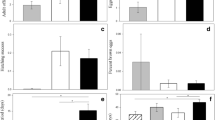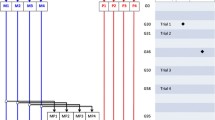Abstract
In nature, behavioural and physiological processes involved in mating may entail different costs and benefits for males and females. However, it has been hypothesized that sexual interactions may have additional costs for Drosophila females like decrease in receptivity to remating and shortening of lifespan. During mating, males transfer seminal fluid proteins to females that exert severe physiological changes that may compromise female’s lifespan and reproductive success. However, under specific stressful environmental conditions that organisms usually face in nature, mating may also confer benefits to females. In the present work, we examine the effect of mating on starvation resistance in wild Drosophila melanogaster. We demonstrate that mated females derived from different geographic locations have the benefit of a greater starvation resistance as compared to virgin females. Even though mating status did not affect mean starvation resistance, we detected a strong genotype-specific effect in males. Beyond the obvious advantage of mating, our study reveals that mating might not be perilous for females, as envisaged by sexual conflict theories, but advantageous for flies exposed to shifts in environmental conditions. Thus, our results highlight the importance of studying other ecologically relevant traits that may contribute to the evolution of male–female interactions.


Similar content being viewed by others
References
Arnqvist G, Nilsson T (2000) The evolution of polyandry: multiple mating and female fitness in insect. Anim Behav 60:145–164
Arnqvist G, Rowe L (2002) Antagonistic coevolutoin between the sexes in a group of insects. Nature 415:787–789
Avila FW, Sirot LK, LaFlamme BA, Rubinstein CD, Wolfner MF (2011) Insect seminal fluid proteins: identification and function. Annu Rev Entomol 56:21–40
Ayroles JF, Carbone MA, Stone EA, Jordan KW, Lyman RF, Magwire MM et al (2009) Systems genetics of complex traits in Drosophila melanogaster. Nat Genet 41:299–307
Boucher L, Huignard J (1987) Transfer of male secretions from the spermatophore to the female insect Caryedon serratus (OI.): analysis of the possible trophic role of these secretions. J Insect Physiol 33:949–957
Boulétreau-Merle J, Fouillet P (2002) How to overwinter and be a founder: egg-retention phenotypes and mating status in Drosophila melanogaster. Evol Ecol 16:309–332
Bownes M (1989) The roles of juvenile hormone, ecdysone and the ovary in the control of Drosophila vitellogenesis. J Insect Physiol 35:409–414
Breitmeyer CM, Markow TA (1988) Resource availability and population size in cactophilic Drosophila. Funct.Ecol 12:14–21
Butlin RK, Woodhatch CW, Hewitt GM (1987) Male spermatophore investment increases female fecundity in a grasshopper. Evolution 41:221–225
Candolin U, Heuschele J (2008) Is sexual selection beneficial during adaptation to environmental change? Trends Ecol Evol 23:446–452
Carvalho GB, Kapahi P, Anderson DJ, Benzer S (2006) Allocrine modulation of feeding behavior by the sex peptide of Drosophila. Curr Biol 16:692–696
Chapman T, Davies SJ (2004) Functions and analysis of the seminal fluid proteins of male Drosophila melanogaster fruit flies. Peptides 25:1477–1490
Chapman T, Partridge L (1996) Female fitness in Drosophila melanogaster: an interaction between the effect of nutrition and of encounter rate with males. Proc R Soc B 263:755–759
Chapman T, Liddle LF, Kalb JM, Wolfner MF, Partridge L (1995) Cost of mating in Drosophila melanogaster females is mediated by male accessory gland products. Nature 373:241–244
Chapman T, Arnqvist G, Bangham J, Rowe L (2003a) Sexual conflict. Trends Ecol Evol 18:41–47
Chapman T, Bangham J, Vinti G, Seifried B, Lung O, Wolfner MF, Smith HK, Partridge L (2003b) The sex peptide of Drosophila melanogaster: female post-mating responses analyzed by using RNA interference. PNAS 100:9923–9928
Chippindale AK, Chu TJF, Rose MR (1996) Complex trade-offs and the evolution of starvation resistance in Drosophila melanogaster. Evolution 50:753–766
Civetta A, Clark AG (2000) Correlated effects of sperm competition and postmating female mortality. PNAS 97:13162–13165
Cordero C, Eberhard WG (2003) Female choice of sexually antagonistic male adaptations: a critical review of some current research. J Evol Biol 16:1–6
Cordero C, Eberhard WG (2005) Interactions between sexually antagonistic selection and mate choice in the evolution of female responses to male traits. Evol Ecol 19:111–122
David JR, Gibert P, Legout H, Petavy G, Capy P, Moreteau B (2005) Isofemale lines in Drosophila: an empirical approach to quantitative traits analysis in natural populations. Heredity 94:3–12
Djawdan M, Chippindale AK, Rose MR, Bradley TJ (1998) Metabolic reserves and evolved stress resistance in Drosophila melanogaster. Physiol Zool 71:584–594
Domanitskaya EV, Liu H, Chen S, Kubli E (2007) The hydroxyproline motif of male sex peptide elicits the innate immune response in Drosophila females. FEBS Journal 274:5659–5668
Edvardsson M (2006) Female Callosobruchus maculatus mate when they are thirsty: resource-rich ejaculates as mating effort in a beetle. Anim Behav 74:183–188
Fricke C, Bretman A, Chapman T (2008) Adult male nutrition and reproductive success in Drosophila melanogaster. Evolution 62:3170–3177
Fricke C, Wigby S, Hobbs R, Chapman T (2009) The benefits of male ejaculate sex peptide transfer in Drosophila melanogaster. J Evol Biol 22:275–286
Fricke C, Bretman A, Chapman T (2010) Female nutritional status determines the magnitude and sign of responses to a male ejaculate signal in Drosophila melanogaster. J Evol Biol 23:157–165
Goenaga J, Fanara JJ, Hasson E (2010) A quantitative genetic study of starvation resistance at different geographic scales in natural populations of Drosophila melanogaster. Genet Res 92:253–259
Gwynne DT (2008) Sexual conflict over nuptial gifts in insect. Annu Rev Entomol 53:83–101
Harbison ST, Yamamoto AH, Fanara JJ, Norga KK, Mackay TFC (2004) Quantitative trait loci affecting starvation resistance in Drosophila melanogaster. Genetics 166:1807–1823
Harshman LG, Schmid JL (1998) Evolution of starvation resistance in Drosophila melanogaster: aspects of metabolism and counter-impact selection. Evolution 52:1679–1685
Himuro C, Fujisaki K (2010) Mating experience weakens starvation tolerance in the seed bug Togo hemipterus (Heteroptera: Lygaeidae). Physiol Entomol 35:128–133
Hoffmann AA, Parsons PA (1991) Evolutionary genetics and environmental stress. Oxford University Press, New York
Hoffmann AA, Anderson A, Hallas R (2002) Opposing clines for high and low temperature resistance in Drosophila melanogaster. Ecol Lett 5:614–618
Hoffmann AA, Shirriffs J, Scott M (2005a) Relative importance of plastic vs genetic factors in adaptive differentiation: geographical variation for stress resistance in Drosophila melanogaster from eastern Australia. Funct Ecol 19:222–227
Hoffmann AA, Hallas R, Anderson AR, Telonis-Scott M (2005b) Evidence for a robust sex-specific trade-off between cold resistance and starvation resistance in Drosophila melanogaster. J Evol Biol 18:804–810
Holland B, Rice WR (1998) Chase-away selection: antagonistic seduction versus resistance. Evolution 52:1–7
Ivy TM, Johnson JC, Sakaluk SK (1999) Hydration benefits to courtship feeding in crickets. Proc R Soc B 266:1523–1527
Izquierdo JI (1991) How does Drosophila melanogaster overwinter? Entomol Exp Appl 59:51–58
Johnstone RA, Keller L (2000) How males gain by harming their mates: sexual conflict, seminal toxins, and the cost of mating. Am Nat 156:368–377
Kenny M, Wilton A, Ballard WO (2008) Seasonal trade-off between starvation resistance and cold resistance in temperate wild-caught Drosophila simulans. Austr J Entomol 47:20–23
Knowles LL, Hernandez BB, Markow TA (2004) Exploring the consequences of postmating-prezygotic interactions between the sexes. Proc R Soc B 271(Suppl 5):S357–S359
Knowles LL, Hernandez BB, Markow TA (2005) Nonantagonistic interactions between the sexes revealed by the ecological consequences of reproductive traits. J Evol Biol 18:156–161
Koehn RK, Bayne BL (1989) Towards a physiological and genetical understanding of the energetics of the stress response. Biol J Linn Soc 37:157–171
Kubli E (2003) Sex-peptides: seminal peptides of the Drosophila male. Cell Mol Life Sci 60:1689–1704
Liu H, Kubli E (2003) Sex-peptide is the molecular basis of the sperm effect in Drosophila melanogaster. PNAS 100:9929–9933
Lung O, Tram U, Finnerty CM, Eipper-Mains MA, Kalb JM, Wolfner MF (2002) The Drosophila melanogaster seminal fluid protein Acp62F is a protease inhibitor that is toxic upon ectopic expression. Genetics 160:211–224
Markow TA, O’Grady PM (2005) Evolutionary genetics of reproductive behavior in Drosophila: connecting the dots. Annu Rev Genet 39:263–291
Mitrovski P, Hoffmann AA (2001) Postponed reproduction as an adaptation to winter conditions in Drosophila melanogaster: evidence for clinal variation under semi-natural conditions. Proc R Soc B 268:2163–2168
Muir WM, Nyquist Y, Xu S (1992) Alternative partitioning of the genotype by environment interaction. Theor Appl Genet 84:193–200
Partridge L, Hurst LD (1998) Sex and conflict. Science 281:2003–2008
Pischedda A, Chippindale AK (2006) Intralocus sexual conflict diminishes the benefits of sexual selection. PLoS Biol 4:e356
Pitnick S, Spicer GS, Markow TA (1997) Phylogenetic examination of female incorporation of ejaculate in Drosophila. Evolution 51:833–845
Randall D, Burggren W, French K (1997) Eckert animal physiology: mechanisms and adaptations, 4th edn. W.H. Freeman & Company, New York
Ravi Ram K, Wolfner MF (2007) Seminal influences: Drosophila Acps and the molecular interplay between males and females during reproduction. Integr Comp Biol 47:427–445
Riddiford LM (1993) Hormones and Drosophila development. In: Bate M, Martinez Arias A (eds) The development of Drosophila melanogaster. Cold Spring Harbor Laboratory Press, Cold Spring Harbor, pp 899–939
Rion S, Kawecki TJ (2007) Evolutionary biology of starvation resistance: what we have learned from Drosophila. J Evol Biol 20:1655–1664
Robertson A (1959) The sampling variance of the genetic correlation coefficient. Biometric 15:469–485
Robinson SJW, Zwaan B, Partridge L (2000) Starvation resistance and adult body composition in a latitudinal cline of Drosophila melanogaster. Evolution 54:1819–1824
Rush B, Sandver S, Bruer J, Roche R, Wells M, Giebultowicz J (2007) Mating increases starvation resistance and decreases oxidative stress resistance in Drosophila melanogaster females. Aging Cell 6:723–726
Service P (1989) The effect of mating status on lifespan, egg laying, and starvation resistance in Drosophila melanogaster in relation to selection on longevity. J Insect Physiol 35:447–452
Soller M, Bownes M, Kubli E (1999) Control of oocyte maturation in sexually mature Drosophila females. Dev Biol 208:337–351
StatSoft (2007) Methods and applications. Version 8.0 StatSoft, Tulsa
Stoltz JA, Hanna R, Andrade MCB (2010) Longevity cost of remaining unmated under dietary restriction. Func Ecol 24:1270–1280
Wigby S, Chapman T (2005) Sex peptide causes mating costs in female Drosophila melanogaster. Curr Biol 15:316–321
Wolfner MF (1997) Tokens of love: functions and regulation of Drosophila male accessory gland products. Insect Biochem Molec Biol 27:179–192
Wolfner MF (2002) The gifts that keep on giving: physiological functions and evolutionary dynamics of male seminal proteins in Drosophila. Heredity 88:85–93
Acknowledgments
The authors wish to thank J. A. Endler (Editor in Chief), D. Hosken and M. Hall (Associate Editors) and two anonymous reviewers for critical suggestions and advice that helped to improve previous versions of this paper. This research was supported by grants from CONICET, ANPCyT and Universidad de Buenos Aires. J. G. was recipient of a fellowship from University of Buenos Aires, J. M. is recipient of a fellowship from CONICET. J. J. F. and E. H. members of Carrera de Investigador Científico of CONICET (Argentina).
Author information
Authors and Affiliations
Corresponding author
Rights and permissions
About this article
Cite this article
Goenaga, J., Mensch, J., Fanara, J.J. et al. The effect of mating on starvation resistance in natural populations of Drosophila melanogaster . Evol Ecol 26, 813–823 (2012). https://doi.org/10.1007/s10682-011-9540-4
Received:
Accepted:
Published:
Issue Date:
DOI: https://doi.org/10.1007/s10682-011-9540-4




